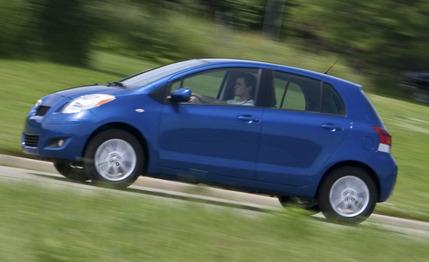
 Short Take Road Test
Short Take Road Test
With wallets hurting and fuel prices seemingly bounding back toward “expensive,” B-class econoboxes are focal points for nearly every automaker: Honda, for example, recently rolled out the second-generation Fit; Ford is gearing up to launch its much-hyped Fiesta in North America; and even Aston Martin believes its well-heeled customers are in need of a reskinned Toyota iQ minicar to complement the six-figure supercars in their garages. Toyota was quick to offer such a car here when it replaced the dorky Echo with the only slightly less-dorky 2007 Yaris three-door hatchback and sedan. And despite the Yaris not having been available in a more useful, five-door-hatch variant until 2009—as well as finishing midpack in our last $15,000 small-car comparison test, behind the Fit, the Nissan Versa, and the Kia Rio5—the model has been at or near the top of the segment in sales since its debut.
More Openings, Same Car
All Yarises get a minor refresh for 2009, but the look and feel of the five-door still shouts bland and inexpensive, and it has a face only a mother could love. But excitement and knee-weakening styling aren’t why people gravitate to one of these workday runabouts. For what it’s worth, though, the newest Yaris probably is the best-looking of the trio, and the five-door body offers the greatest versatility from the smallest footprint, a boon for in-town maneuverability. However, that compactness also means it’s small inside, with only 26 cubic feet of storage space with the rear seats folded, same as in the three-door. The extra openings make utilizing that space a bit easier than before, and the optional 60/40 split rear bench has a neat reclining and sliding feature for extra legroom. But the resulting load area isn’t as flat, expansive, or cargo-friendly as the smaller Honda Fit’s 42 cubes. Up front and center, literally, is a quirky gauge cluster integrated into the middle of the dash. It’s a cost-cutting annoyance that allows easy assembly for multiple global markets, but such a setup doesn’t work well when actually driving. Devoid of a tachometer or means to view fuel economy—which you probably want to know about if you’re shopping for such a vehicle—the Yaris’s cluster was as uninformative as it was distracting to look at when moving. Other irksome ergonomic areas include the lack of telescopic adjustment for the steering wheel; tight front footwells; awkwardly placed cup holders; and cheap, hard plastic everywhere. Now, we don’t expect the sybaritic innards of an Audi for $15,000, but more amenities and refinement in such half-pint cars—okay, any amenities and refinement—would be key in attracting Americans downsizing from larger, better-equipped vehicles.
Automatic Only = Cruel and Unusual Punishment
Whereas other body styles come standard with a five-speed manual transmission, the five-door is offered only with the otherwise optional four-speed automatic. Its plodding shifts and widely spaced ratios mean that the 106-hp, 1.5-liter four-cylinder must work hard for the Yaris to keep up with traffic—wide-open throttle is where we usually found ourselves. That behavior saps fuel economy. We observed only 29 mpg overall in the five-door versus 36 for the last Yaris we tested, a sedan with the manual and 55 fewer pounds to haul around. Against that same Yaris sedan, our five-door was nearly two seconds slower to 60 mph, more than a second lazier through the quarter-mile, and took 17 feet longer to stop from 70 mph. The Yaris’s low overall weight and short wheelbase make it somewhat tossable and agile—the lack of a clutch and shifter, however, kills any excitement to be had. The little Toyota returned 0.79 g on the skidpad. That’s about the same as we’ve seen from the 10Best-winning Fit, but the Honda is ultimately more tactile and rewarding and is more fun to drive than some vehicles costing several times as much. One large concern with the Yaris—and any other vehicle this boxy and light—is vulnerability to high winds, and that makes passing semis on the highway feel as though you were driving through a tornado.
Affordability Comes at a Price
Although a base three-door Yaris can be had for just under $13,000, our five-door tester started at $14,055 and quickly ballooned to more than $17,000 with options, including vehicle security, cruise control, keyless entry, a cold-weather package, and the Power package (power windows, mirrors, and locks; an upgraded stereo; satellite radio; and 15-inch alloy wheels wearing Bridgestone Potenza all-season rubber). Anti-lock brakes are standard and a full array of airbags is available, yet electronic stability control is not. These prices are in the ballpark with those of competitors, but we can’t help making a comparison with the Fit, which is better packaged with more usable space, feels more refined behind the wheel, and is better equipped at a starting price of $15,460. At least Toyota now offers buyers three different Yarises to choose from. Too bad none of them seems particularly well equipped for a possible small-car revolution.